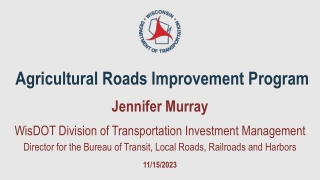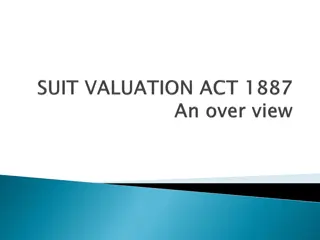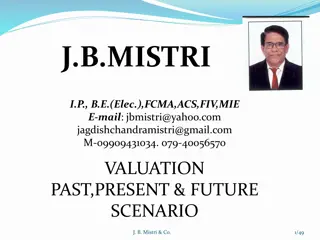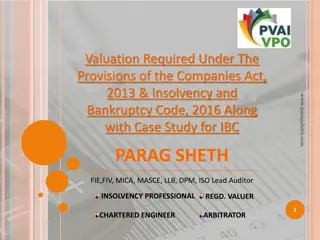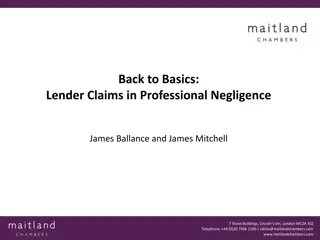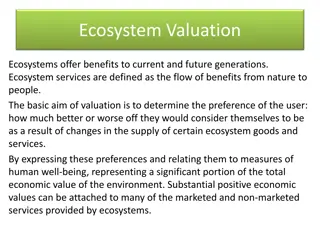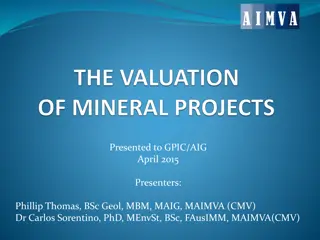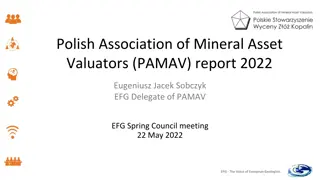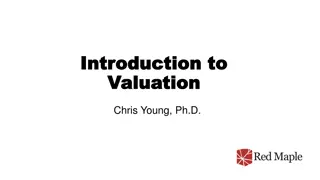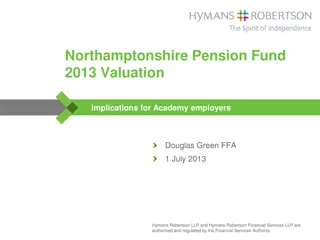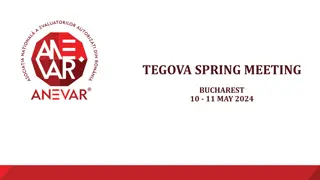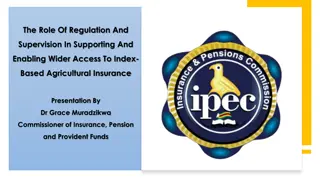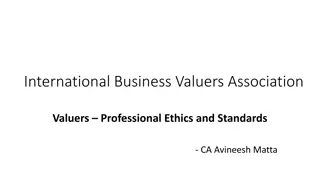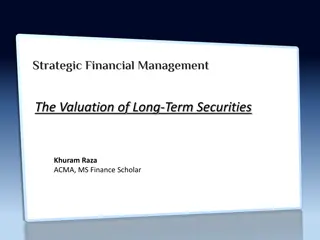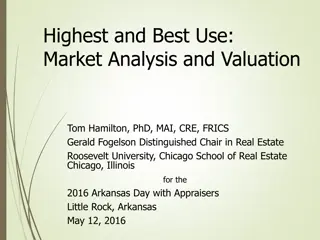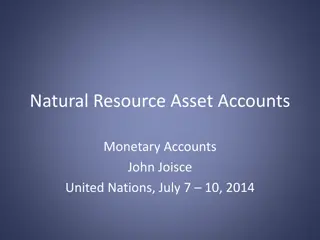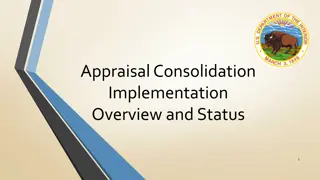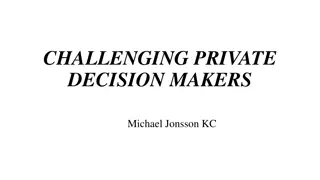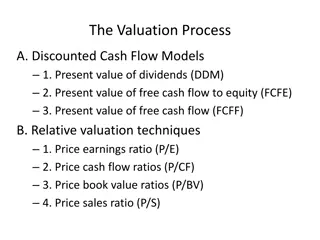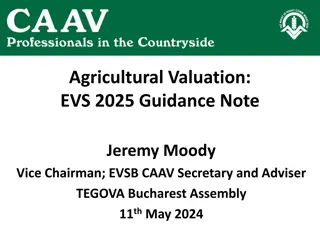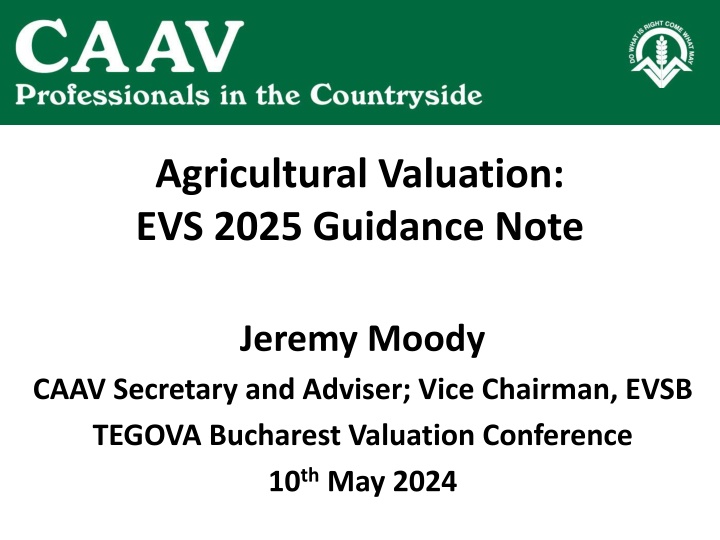
Agricultural Valuation and Valuers Overview
Valuable insights into agricultural valuation profession and the role of agricultural valuers in advising farmers, landowners, and agri-businesses. Discover the diverse landscape of agriculture across Europe and the drivers of change impacting the industry.
Download Presentation

Please find below an Image/Link to download the presentation.
The content on the website is provided AS IS for your information and personal use only. It may not be sold, licensed, or shared on other websites without obtaining consent from the author. If you encounter any issues during the download, it is possible that the publisher has removed the file from their server.
You are allowed to download the files provided on this website for personal or commercial use, subject to the condition that they are used lawfully. All files are the property of their respective owners.
The content on the website is provided AS IS for your information and personal use only. It may not be sold, licensed, or shared on other websites without obtaining consent from the author.
E N D
Presentation Transcript
Agricultural Valuation: EVS 2025 Guidance Note Jeremy Moody CAAV Secretary and Adviser; Vice Chairman, EVSB TEGOVA Bucharest Valuation Conference 10thMay 2024
Agricultural Valuers CAAV: Professional Association UK-wide specialist professional association for those acting for and advising farmers, owners and others in the rural economy Representing, briefing, qualifying agricultural valuers Qualified Fellows are FAAV Representing practicality, not interests Have to give the right advice to each client 114 years old with growing work and activity
Valuation and Agriculture Valuation profession started with farmland Often for taxation, for management Largest use by area of land in most countries Character varies by country and area Typically working for and advising individual owners, farmers, families Often with long histories on the land Also agri-business, investors, lenders, new owners, Ownership and use can be politically sensitive Facing substantial change
Agriculture Across Europe Very varied types and structures From Malta to Finland; Ireland to Ukraine Perennial crops to extensive livestock Agri-business to part-time small farms Subsistence, producing commodities, brand and added value to tourism and other business Very different national histories, laws, cultures Increasing divergence within EU CAP and then UK, Switzerland, Norway, Ukraine have own polices, Different land laws for ownership and tenancy Land reform, revolution, collectivisation,
The Drivers of Change Geopolitical risk for global supply chains 2011 Arab Spring followed wheat price spike Russia, Middle East . Climate change and net zero policies Flood, storm, drought, dire, snow Changing conditions for farming; more risk Renewable energy, generation, transmission, use Competition for land use Housing, infrastructure, nature, carbon, leisure New technologies
EVS 2025 - Agriculture Guidance Note on Agriculture in EVS 2003 but not since Now included in EVS 2025 Now drafted for this Bucharest Assembly Prepared with a working group from Bulgaria, Italy, Portugal and UK and TEGOVA Chairman Benefited from the Lisbon conference in March Blue Book to have a shorter Guidance Note Longer Guidance Note covering more issues to go on TEGOVA s website
Blue Book Topics Introduction Application of European Valuation Standards Valuation Methodology Determination of a Property s Market Value And then new developments Climate Change Technology, Data and Farmland Finally Template EVS Agricultural Valuation Report
Website Note Topics - 1 The Nature of Agricultural Property Tenure, Occupation and Business Arrangements Agricultural Tenancies Other Business Structures Land: Bare or Equipped Specialist Buildings Land or Estate Pressures to Restructure; Other General Points
Website Note Topics - 2 Commonly Relevant Characteristics The Influence of Agricultural Policies Support payments linked to land or not? Other policies and controls? Other Sources of Value Likely Sources of Information Agricultural Crops and Other Assets Perennial Crops Cost, net income over time, exit cost land? Forestry
Valuations Standards Apply As in all other sectors and circumstances, EVS1-5 apply to agricultural valuations EVS1 Definitions and understanding of market value and market rent Including assumptions and special assumptions EVS2 Other bases of value EVS3 The skilled valuer within competence EVS4 The valuation process EVS5 The valuation report
Markets for Valuation Vary widely across Europe and within countries Are sales and lettings market active? Are sales and lettings markets transparent? How does national law/tax regulate ownership, land use, letting and sale, inheritance, ? Is it food production from land or by high investment in facilities on land? Why does land have value? Food production potential or other factors Licences and permissions, contracts and water,
Location and the Market Whole farms that can be run as a unit might have a wider market Smaller farms and land parcels might have most value to local farming buyers To add to existing farms Often when little land has been locally available So often a pattern of interlocking local markets Within range for machinery and management What are characteristics of local buyers?
Land and Business Unlike other businesses, farming uses land in its business Seeds grow in land, fertility to be cared for, etc Not just premises In some countries land is primarily valued for food production potential In others, more factors are to be considered Both need fixed equipment and buildings But some business is in buildings, glass houses, etc using land as location Value in efficiency of buildings, contracts, etc
Why Value? Many reasons for a sector largely of families Sale/purchase or lease (also during and at end) Business: creation, end or decisions Secured lending Inheritance, divorce, property disputes Statute taxation, compulsory purchase, Insurance, damage assessment But also valuations for compensation and dilapidations on the end of a tenancy Values of crops, livestock, machinery
Inquire and Understand I keep six honest serving ,men (They taught me all I knew) Their names are What and Why and When And How and Where and Who. Rudyard Kipling The Elephant s Child, Just So
Know the Farm and its Context Understand the farm Its soils, topography, fixed equipment, buildings, etc How should it be farmed? What yields are expected with what costs and risks? Could they be improved? What permissions and limitations are relevant? Water, produce contracts, access What other uses might it have alongside or instead of farming Development, tourism, energy, sporting, forestry, ? Environment, nature, carbon, water management ?
Know the Market Who might be the buyers? How many might be interested? Why might they buy? Do they want extra land? Or starting farming? Residential and other motives? New uses? Are there other sellers? How competitive is the market? Do buyers need to borrow for this? How available is finance? Other recent transactions?
Approaches to Valuation - 1 Comparison and adjustment Typically the best method, directly from the market Based on actual transactions, closer in nature/time Testing the balance of supply and demand for: Different types and sizes of unit Different types of farming potential Different resources buildings, dwellings, water, power, access to government and other schemes Adjusting those prices to the property being valued Needs a good knowledge of farms and markets BUT not easy in all markets lack of good data
Approaches to Valuation - 2 How to use an income method? For land work from rents Gross or net? with what rate? How secure? Business work from sustainable profit With what rate? With more risk? What is the security of that profit? Is that profit personal or transferable? Will buildings last? Is contract durable or transferable BUT agricultural rates often below bank rates Reflecting other factors and motives Values become very sensitive to chosen low rates
Approaches to Valuation - 3 Depreciated Replacement Cost Unlikely for land but perhaps buildings Especially specialist buildings: glasshouses, pig units Perhaps other specialist enterprises Based on cost, not value Always a sense check at the end Would someone really pay the value assessed? The more adjustments and arithmetic, the more precarious the figure The client will rely on the valuation to spend or make a commitment/decision or to avoid one.
Developing Issues Risk, opportunity, resilience Geopolitical risk Changing supply chains and markets Competition for land use Climate change Mitigation and Net Zero reducing carbon and more renewable energy Adaptation for more extreme weathers Environmental and nature policies New technologies
Climate Change Impact - with volatile and extreme weather Storms, flood, Periods of extreme hear Drought, wildfire, snow across the world Mitigation emissions reduction Changing practices, renewable energy, carbon sequestration, etc Adaptation how to live with climate it What we do not mitigate we must adapt to More change to come even if policies work
Climate Change and Values? Living with change, so can be hard to see it Creates risk and opportunities No single answer differing by property It can change the potential use of land Some too hot for cereals; others now grow grapes New income for property? Renewable energy, Will risks become too great for some? Repeated flooding may change land use Supply chains - lenders, suppliers, buyers Political and market forces on land use
Adaptation to Climate Change Risk reduction, resilience, opportunities Hot dry periods water use, supply, storage Intense floods ways to limit risk Storms, woodland, infrastrcuture, Soils better soil health; protect from erosion New crops and opportunities New pests and diseases Adapting management livestock, work, staff Impact on larger world food production
Water A Key Issue Water quantity Too much - flooding, saturation of land, damage Flood protection, drainage, water management Natural measures to reduce flood risk Too little threat to farming, careful conservation Permissions to take and store Reservoirs, improved irrigation facilities, etc Water quality Low flows see water reserves become salty Risks to water supply and nature from farming run-off nutrients, chemicals,
Flooding We see more extreme rainstorms First effects where rivers join Then saturate land and surface water flooding Damage/loss for crops, livestock, buildings, feed Loss of soil, soil structure and nutrients More problems with sea flooding Effects on value depend on markets Tends to move land from arable to pasture Winter flooding can benefit pasture Value in flood storage to protect settlements? Attitude of lenders and insurers
The Facts of Environmental Deals What is being sold? At what price? How fettered is the landowner? On what terms? Who has control? How is change large/small then handled? For what price? Capital or revenue? Tax consequences? What are the associated costs? The agreement, monitoring and assurance Associated promotional benefits? When to deal? Is it worth it? What effect on the value of the land?
Valuation of Woodland The ultimate perennial crop? What is its market? Timber, amenity, shelter, ancillary to other activity For timber as an economic use What are the species? What is their market? How well are they established? How well should they grow? yield classes How long till harvest? What costs and works? What risks fire, storm, disease, How easy is it to fell and remove timber Amenity/environment comparison
Environment and Biodiversity Growing concern that society depends on nature Risks to water and air quality, wildlife, More controls over land use and farming practices Water for nature, for farming, for people? Threat or opportunity? Balance with food production How does this affect value? There are environmental buyers in some markets There can be opportunities in environment services Better soils, bees, water management help farming
Technology Technology and farming business Useful to know it and be able to talk with clients Relevant to farm economics But might not directly affect land values Technology and property The data from precision farming relevant to transactions - information for value Automation in high value buildings Glasshouses for horticulture, controlled environment farming, stores and packhouses, pigs and poultry, processing produce
Thank You www.caav.org.uk jeremy@caav.org.uk

